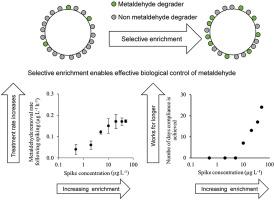Water Research ( IF 12.8 ) Pub Date : 2020-07-06 , DOI: 10.1016/j.watres.2020.116084 Catherine A Rolph 1 , Bruce Jefferson 1 , Adam Brookes 2 , Francis Hassard 1 , Raffaella Villa 3

|
Metaldehyde removal was delivered to below the 0.1 μg L−1 regulatory concentration in a laboratory scale continuous upflow fluidised sand bioreactor that had undergone acclimation through selective enrichment for metaldehyde degradation. This is the first reported case of successful continuous flow biological treatment of metaldehyde from real drinking water sources treating environmentally realistic metaldehyde concentrations. The impact of the acclimation process was impermanent, with the duration of effective treatment directly related to the elevated concentration of metaldehyde used during the enrichment process. The efficacy of the approach was demonstrated in continuous flow columns at both laboratory and pilot scale enabling degradation rates of between 0.1 and 0.2 mg L−1 h−1. Future work needs to focus on optimisation of the sand bioreactor and the acclimation process to ensure viability and feasibility of the approach at full scale.
中文翻译:

使用适应性的沙子生物反应器,以达到饮用水中甲醛的达标水平。
在实验室规模的连续上流流化砂生物反应器中,通过选择性富集进行了降解甲醛的过程,去除的甲醛达到了0.1μgL -1调节浓度以下。这是首次成功地对来自实际饮用水源的甲醛进行连续流式生物处理的案例,该案例对环境中现实的甲醛浓度进行了处理。适应过程的影响是无常的,有效处理的持续时间直接与富集过程中使用的甲醛浓度升高直接相关。该方法的有效性已在实验室和中试规模的连续流色谱柱中得到证实,降解速率在0.1至0.2 mg L -1 h之间-1。未来的工作需要集中在砂生物反应器的优化和适应过程上,以确保该方法的可行性和可行性。



























 京公网安备 11010802027423号
京公网安备 11010802027423号